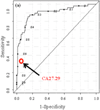Biomarker Discovery and Translation in Metabolomics
- PMID: 27134822
- PMCID: PMC4848463
- DOI: 10.2174/2213235X113019990005
Biomarker Discovery and Translation in Metabolomics
Abstract
The multifaceted field of metabolomics has witnessed exponential growth in both methods development and applications. Owing to the urgent need, a significant fraction of research investigations in the field is focused on understanding, diagnosing and preventing human diseases; hence, the field of biomedicine has been the major beneficiary of metabolomics research. A large body of literature now documents the discovery of numerous potential biomarkers and provides greater insights into pathogeneses of numerous human diseases. A sizable number of findings have been tested for translational applications focusing on disease diagnostics ranging from early detection, to therapy prediction and prognosis, monitoring treatment and recurrence detection, as well as the important area of therapeutic target discovery. Current advances in analytical technologies promise quantitation of biomarkers from even small amounts of bio-specimens using non-invasive or minimally invasive approaches, and facilitate high-throughput analysis required for real time applications in clinical settings. Nevertheless, a number of challenges exist that have thus far delayed the translation of a majority of promising biomarker discoveries to the clinic. This article presents advances in the field of metabolomics with emphasis on biomarker discovery and translational efforts, highlighting the current status, challenges and future directions.
Keywords: Biomarkers; NMR spectroscopy; cancer; cardiovascular disease; commercialization; diabetes; diagnostics; inborn errors of metabolism; mass spectrometry; metabolomics; neurological disorder; statistical analysis; translation; validation.
Conflict of interest statement
Daniel Raftery reports holding equity and an executive role in Matrix-Bio, Inc.
Figures




References
-
- Djukovic D, Nagana Gowda GA, Raftery D. Mass Spectrometry and NMR Spectroscopy Based Quantitative Metabolomics. In: Isssaq HJ, Veenstra TD, editors. Proteomic and Metabolomic Approaches to Biomarker Discovery. Amsterdam: Academic Press; 2013. pp. 279–298. Ch 18.
-
- Nicholson JK, Holmes E, Kinross JM, Darzi AW, Takats Z, Lindon JC. Metabolic phenotyping in clinical and surgical environments. Nature. 2012;491:384–392. - PubMed
-
- Wise DR, DeBerardinis RJ, Mancuso A, Sayed N, Zhang XY, Pfeiffer HK, Nissim I, Daikhin E, Yudkoff M, McMahon SB, Thompson CB. Myc regulates a transcriptional program that stimulates mitochondrial glutaminolysis and leads to glutamine addiction. Proc. Natl. Acad. Sci. (USA) 2008;105:18782–18787. - PMC - PubMed
-
- Locasale JW, Grassian AR, Melman T, Lyssiotis CA, Mattaini KR, Bass AJ, Heffron G, Metallo CM, Muranen T, Sharfi H, Sasaki AT, Anastasiou D, Mullarky E, Vokes NI, Sasaki M, Beroukhim R, Stephanopoulos G, Ligon AH, Meyerson M, Richardson AL, Chin L, Wagner G, Asara JM, Brugge JS, Cantley LC, Vander Heiden MG. Phosphoglycerate dehydrogenase diverts glycolytic flux and contributes to oncogenesis. Nature Genetics. 2011;43:869–874. - PMC - PubMed
Grants and funding
LinkOut - more resources
Full Text Sources
Other Literature Sources
